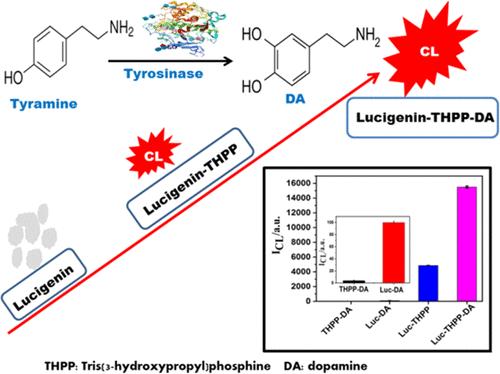当前位置:
X-MOL 学术
›
Anal. Chem.
›
论文详情
Our official English website, www.x-mol.net, welcomes your
feedback! (Note: you will need to create a separate account there.)
Signal-On Detection of Dopamine and Tyrosinase Using Tris(hydroxypropyl)phosphine as a New Lucigenin Chemiluminescence Coreactant
Analytical Chemistry ( IF 6.7 ) Pub Date : 2024-09-05 , DOI: 10.1021/acs.analchem.4c00748
Islam M Mostafa 1, 2 , Abubakar Abdussalam 1, 3 , Hongzhan Liu 1, 4 , Zhiyong Dong 1, 4 , Shiyu Xia 1, 4 , Ala'a Mhmoued Abdllh Alboull 1, 4 , Baohua Lou 1, 4 , Guobao Xu 1, 4
Analytical Chemistry ( IF 6.7 ) Pub Date : 2024-09-05 , DOI: 10.1021/acs.analchem.4c00748
Islam M Mostafa 1, 2 , Abubakar Abdussalam 1, 3 , Hongzhan Liu 1, 4 , Zhiyong Dong 1, 4 , Shiyu Xia 1, 4 , Ala'a Mhmoued Abdllh Alboull 1, 4 , Baohua Lou 1, 4 , Guobao Xu 1, 4
Affiliation

|
Dopamine (DA) is a very imperative neurotransmitter in our body, since it contributes to several physiological processes in our body, for example, memory, feeling, cognition, cardiovascular diseases, and hormone secretion. Meanwhile, tyrosinase is a critical biomarker for several dangerous skin diseases, including vitiligo and melanoma cancer. Most of the reported chemiluminescent (CL) methods for monitoring DA and tyrosinase are signal-off biosensors. Herein, we introduce a new chemiluminescent “signal-on” system, lucigenin-tris(hydroxypropyl)phosphine (THPP), for the selective determination of DA and tyrosinase. THPP is well known as a versatile and highly water–soluble sulfhydryl-reducing compound that is more highly stable against air oxidation than common disulfide reductants. By employing THPP for the first time as an efficient lucigenin coreactant, the lucigenin-THPP system has shown a high CL response (approximately 16-fold) compared to the lucigenin-H2O2 classical CL system. Surprisingly, DA can remarkably boost the CL intensity of the lucigenin-THPP CL system. Additionally, tyrosinase can efficiently catalyze the conversion of tyramine to DA. Therefore, lucigenin-THPP was employed as an ultrasensitive and selective signal-on CL system for the quantification of DA, tyrosinase, and THPP. The linear ranges for the quantification of DA, tyrosinase, and THPP were 50–1000 nM, 0.2–50 μg/mL, and 0.1–800 μM, respectively. LODs for DA and tyrosinase were estimated to be 24 nM and 0.18 μg/mL, respectively. Additionally, the CL system has been successfully employed for the detection of tyrosinase in human serum samples and the assay of DA in human serum samples as well as in dopamine injection ampules with excellent obtained recoveries.
中文翻译:

使用三(羟丙基)膦作为新的萜光素化学发光共反应物对多巴胺和酪氨酸酶进行信号检测
多巴胺 (DA) 是我们体内一种非常重要的神经递质,因为它有助于我们体内的多个生理过程,例如记忆、感觉、认知、心血管疾病和激素分泌。同时,酪氨酸酶是多种危险皮肤病的关键生物标志物,包括白癜风和黑色素瘤癌。大多数已报道的用于监测 DA 和酪氨酸酶的化学发光 (CL) 方法是信号关闭生物传感器。在此,我们介绍了一种新的化学发光“信号开启”系统,lucigenin-tris(羟丙基)膦 (THPP),用于选择性测定 DA 和酪氨酸酶。THPP 是一种用途广泛且高度水溶性巯基还原化合物,比普通的二硫化物还原剂对空气氧化具有更高的稳定性。通过首次使用 THPP 作为高效的萤光素共反应物,萤光素-THPP 系统显示出与萤光素-H2O2 经典 CL 系统相比的高 CL 响应(约 16 倍)。令人惊讶的是,DA 可以显着提高 lucigenin-THPP CL 系统的 CL 强度。此外,酪氨酸酶可以有效地催化酪胺转化为 DA。因此,萤草素-THPP 被用作 DA、酪氨酸酶和 THPP 定量的超灵敏和选择性信号 CL 系统。DA、酪氨酸酶和 THPP 定量的线性范围分别为 50–1000 nM、0.2–50 μg/mL 和 0.1–800 μM。DA 和酪氨酸酶的 LOD 估计分别为 24 nM 和 0.18 μg/mL。此外,CL 系统已成功用于检测人血清样品中的酪氨酸酶和人血清样品以及多巴胺注射安瓿瓶中的 DA 检测,并获得了优异的回收率。
更新日期:2024-09-05
中文翻译:

使用三(羟丙基)膦作为新的萜光素化学发光共反应物对多巴胺和酪氨酸酶进行信号检测
多巴胺 (DA) 是我们体内一种非常重要的神经递质,因为它有助于我们体内的多个生理过程,例如记忆、感觉、认知、心血管疾病和激素分泌。同时,酪氨酸酶是多种危险皮肤病的关键生物标志物,包括白癜风和黑色素瘤癌。大多数已报道的用于监测 DA 和酪氨酸酶的化学发光 (CL) 方法是信号关闭生物传感器。在此,我们介绍了一种新的化学发光“信号开启”系统,lucigenin-tris(羟丙基)膦 (THPP),用于选择性测定 DA 和酪氨酸酶。THPP 是一种用途广泛且高度水溶性巯基还原化合物,比普通的二硫化物还原剂对空气氧化具有更高的稳定性。通过首次使用 THPP 作为高效的萤光素共反应物,萤光素-THPP 系统显示出与萤光素-H2O2 经典 CL 系统相比的高 CL 响应(约 16 倍)。令人惊讶的是,DA 可以显着提高 lucigenin-THPP CL 系统的 CL 强度。此外,酪氨酸酶可以有效地催化酪胺转化为 DA。因此,萤草素-THPP 被用作 DA、酪氨酸酶和 THPP 定量的超灵敏和选择性信号 CL 系统。DA、酪氨酸酶和 THPP 定量的线性范围分别为 50–1000 nM、0.2–50 μg/mL 和 0.1–800 μM。DA 和酪氨酸酶的 LOD 估计分别为 24 nM 和 0.18 μg/mL。此外,CL 系统已成功用于检测人血清样品中的酪氨酸酶和人血清样品以及多巴胺注射安瓿瓶中的 DA 检测,并获得了优异的回收率。







































 京公网安备 11010802027423号
京公网安备 11010802027423号